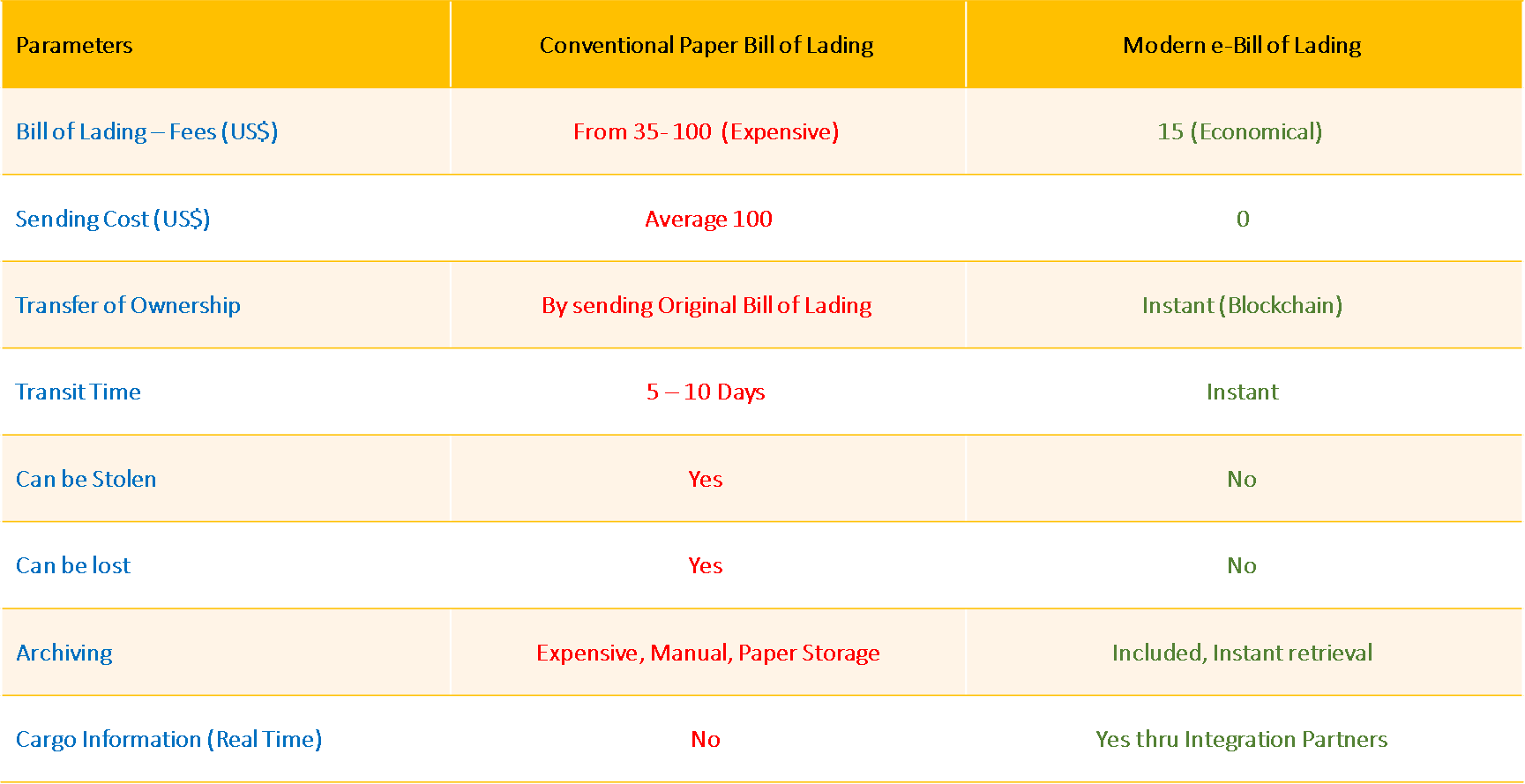Benefits of Electronic Bill of Lading (e-BL) over Conventional Paper Bill of Lading


Electronic bills of lading enable digital document of title transfer, preserving all the functions of a paper bill of lading while improving speed, cost-efficiency, and reducing the risk of delays. Blockchain brings major improvements to the core electronic B/L functionality.
A blockchain bill of lading (or a smart bill of lading) is a special type of electronic bill of lading that uses blockchain technology for an immutable audit trail, ultimate transparency of business events, and unbreakable confidentiality among business partners. Blockchain bills of lading make it possible for businesses to build deep levels of trust, automated processing of release, improve workload planning, and even help analyze processes and make reliable projections on a large scale.
Electronic B/L solutions, designed around a decade ago, were built with traditional IT architecture, where ownership was not really auditable all the time, as the technology did not necessarily support an immutable and tamper-proof environment. Electronic BL services were complex to use, and consequently, the companies using them were not yet able to see the added value of a digital bill of lading processing. Blockchain changes that profoundly.
Smart, modern electronic bills of lading, built on blockchain technology, introduce unsurpassed auditability and digital security features while preserving all the features of the paper B/L. The digital bills of lading (or electronic bills of lading or Smart B/L) of yesterday did not have these properties.
While using a blockchain-based electronic bill of lading, military-grade encryption is used to secure the confidential content of both the documents and owner’s identity, while the transfer of ownership is validated in a distributed, global, and immutable transactional environment. The neutral, public blockchain provides an impeccable system of validation and auditing transactions of documents of title.
These features provide more trust in digital transfer, and processing, and also bridge the gaps in time, risk, and cost inefficiencies. A smart bill of lading can trigger other processes automatically, as it has very high levels of information reliability!
Main properties of electronic, blockchain-based bills of lading
The electronic bill of lading’s architecture provides the following benefits to the companies that use them:
- Higher level of security through immutable transaction records
- Owner validation prevents mis deliveries
- Fast distribution around the globe prevents damage and demurrage costs
- Radically lower costs of sending, processing, and archiving
- Cannot be lost, stolen, or tampered with
- Secure end-to-end documentation process
- Reduced credit time in financial transactions
- Access to trade finance under eUCP600 rules
According to the eUCP rules, an electronic bill of lading is part of the documentary payment process and electronic documents presentation.
This all is of extreme importance, as – according to research by Maersk and IBM – one container shipment can generate 200 communications, and the administrative cost of merely processing the documentation is estimated at 15-20% of the overall cost of transporting the goods.
Electronic bills of lading prevent the following situations:
- Physical bill of lading is not available
- Multiple persons demanding delivery of the cargo
- Amending the bill of lading after the document has been signed and sent
- Agents providing unauthorized information on the bill of lading
Seven key platforms for eBL
The IGP&I has so far approved seven different platforms for electronic bill of lading transfer. The e-BL Platform for Blockchain Document Transfer (BDT) utilizes the neutral, public blockchain technology to do so. This provides a significant advantage, providing unsurpassable transparency, as well as immutable audit trail, and unbreakable confidentiality among business partners.
Bill of lading regulation
Bills of lading fulfill three main functions: they act as a receipt for the shipment of the goods, they provide evidence of the terms of the contract between the carrier and the cargo owner, and they serve as documents of title.
These functions of the bills of lading are defined by law and global agreements, such as :
- Carriage of Goods by Sea Act 1992 (COGSA), that replaced the Bills of Lading Act of the UK (1855)
- Hague (-Visby) Rules (1924)
- Hamburg Rules (1978)
- Rotterdam Rules (2009)
- Other laws and regulations
New developments in global trade regulation
There are many ongoing activities to define the standards and frameworks for the global shipping industry and to facilitate frictionless global trade.
e-BL platforms follows them closely and contributes to the efforts of international bodies to build standardized formats.
Generally, to be up to speed with the development of the e-BL, it is recommended to closely observe the following:
- United Nations Commission on International Trade Law (UNCITRAL) draft Model Law on Electronic Transferable Records (MLETR).
- International Chamber of Commerce (ICC) Uniform Rules for Digital Trade Transactions (URDTT) Version 1.0 and UCP600 rules on documentary credits for the financial sector.
- Digital Container Shipping Association (DCSA), bringing together the biggest shipping companies in the world – MSC, Maersk, CMA CGM, Hapag-Lloyd, ONE, Evergreen, Yang Ming, HMM, and ZIM, e-Documentation initiative Standards for the Bill of Lading
- International Trade & Forfaiting Association (ITFA) Digital Negotiable Instruments Initiative (DNI).
- Group of Seven (G7) Trade Ministers' Digital Trade Principles.
- UN Centre for Trade Facilitation and Electronic Business (UN/CEFACT); Multimodal Transport Reference Data Model.
- Baltic and International Maritime Council (BIMCO) standalone Electronic Bill of Lading Clause (2014).
- International Federation of Freight Forwarders Associations, developing a e-FIATA Bill of Lading, has announced the standard and tools to be published soon.

